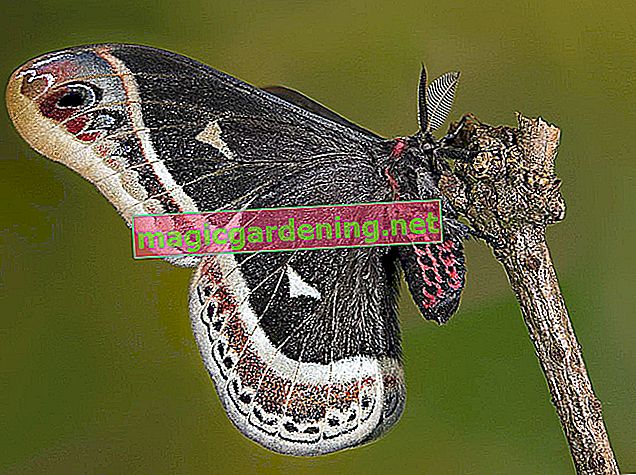
Everything about bumblebees
Bumblebees are a genus with the scientific name of bombus that belongs to the real bees. The state-forming insects are a lower classification within the hymenoptera and belong to the stinging or weir voice. Their main area of distribution extends over the temperate and cooler latitudes. In their way of life they hardly differ from that of the bees.
also read
- Bumblebees in the insect hotel
- What can be done against bumblebees in the nesting box?
- Norway maple in profile - important features at a glance
| answer | |
|---|---|
| What do bumblebees eat? | Pollen and nectar |
| How long do bumblebees live? | Lifespan between two weeks and a year |
| Where do bumblebees sleep | sleep on blossoms |
| When do bumblebees die? | when there is a lack of food and due to cold |
natural reserve
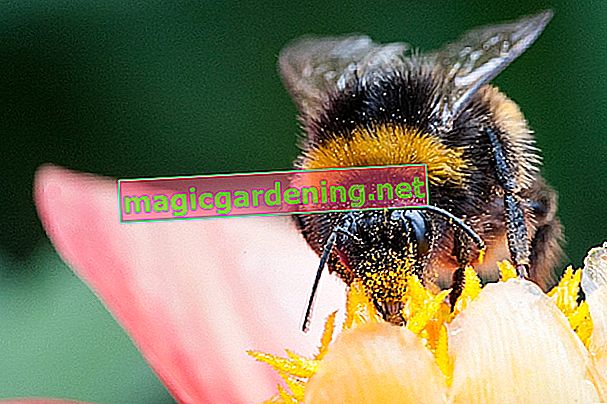
The hard-working insects take on important functions in the ecosystem. They are outnumbered by other True Bees and are threatened by the decline in food sources and habitats. Protected and undisturbed wintering quarters are especially important for the wintering young queens. These are also disappearing more and more, which is why the insects are protected by the Nature Conservation Act. Protection continues to exist through the Species Protection Act, because bumblebees are endangered by the use of pesticides and early mowing of flower strips.
That is forbidden:
- Trapping and injuring the insects
- intentional killing
- Damaging or destroying breeding sites and resting places
Natural enemies
Bumblebees are parasitized by the closely related cuckoo bumblebees. The males of the big woolly bee defend themselves against flying bees and bumblebees that accidentally get into their territory. They fly towards the intruders and curve their thorny abdomen forwards just before the collision. The wings of bumblebees are often destroyed on impact, rendering them unable to fly and starving to death.
The wax moth poses a greater danger because it can destroy an entire bumblebee colony. It is attracted by the scent of nectar and pollen in the bumblebee nests and lays its eggs there. When the larvae hatch, they eat their way into the combs and devour bumblebee eggs and larvae.
Bumblebees are hosts of bee ants, whose females invade the bumblebee nests and lay one egg per cell. The larvae eat the entire brood and then pupate. Despite this way of life, an infestation with the bee ant does not inevitably result in the demise of the entire bumble bee colony.
Other enemies:
- Dick-headed fly : lays eggs in full-grown bumblebees
- Mites : attack bumblebees and feed on their blood
- Humans : Use of pesticides and insecticides kills bumblebees
How do bumblebees reproduce?
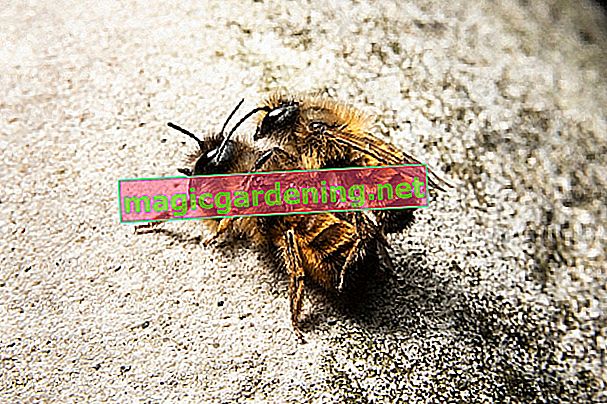
Between July and August, drones prefer large flowers that are rich in nectar. Here they are waiting for a young queen to mate with her. While the queen can only mate once, the drones can mate several females. The fertilized young queens look for a place to hibernate directly after mating.
Summit Balz
The males of the bright earth bumblebee look for exposed spots in the area in order to position themselves there. These can be hills or mountain tops that protrude as far as possible from the landscape. The males are easily recognizable by the females towards the horizon. If they are willing to mate, they fly specifically to these locations.
Patrol flights
In this type of courtship, the males of the dark earth bumblebees, stone bumblebees and garden bumblebees repeatedly fly along fixed routes that are 200 to 300 meters long. The altitude of the drones differs between the species. Garden bumblebees prefer to fly close to the ground, while stone bumblebees can be found near tree tops.
The drones leave pheromones on branches and leaves at a distance of five to ten meters. Females are attracted by the pheromones, which is why the mating chance according to scientific assumptions is greatest in the area of the markings.
Accumulations
Mooshummel drones gather in large numbers in front of the nests of other bumblebee colonies who are not closely related. They stay at the nest exit and wait for the young queens to pour out. Researchers have put forward the theory that males use the smell to orient themselves and thus find foreign nests.
What do bumblebees look like?
Wild bumblebees are difficult to spot in nature. Among the 36 species found in Germany, there are large and small bumblebees that are active at different times. However, the largest period of activity overlaps as most of the nectar plants bloom in summer. To distinguish the seven most common types, the color on the body must be used.
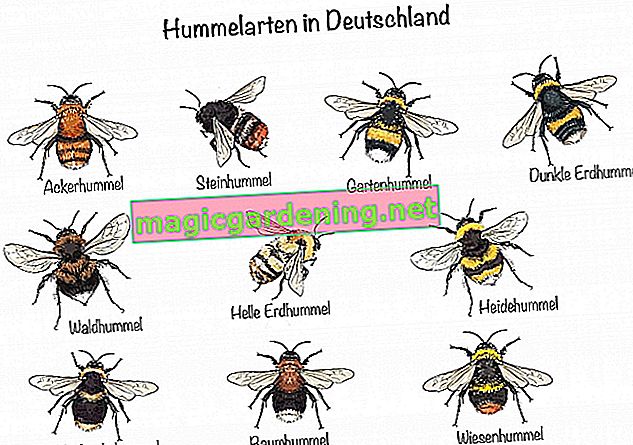
| Flight times | coloring | |
|---|---|---|
| Dark bumblebee | Mid-February to mid-October | two yellow cross bars, white tip of the abdomen |
| Bright bumblebee | March to September | orange-gray to brown bands, white abdomen |
| Stone bumblebee | March to September | The end of the abdomen is brownish red |
| Meadow bumblebee | Mid-February to June | yellow and orange bands |
| Tree bumblebee | Mid February to September | Upper body orange-brown, abdomen black |
| Bumblebee | Mid-March to mid-November | Upper body yellowish to reddish brown, abdomen banded with white |
| Garden bumblebee | March to September | golden yellow bands with black spaces |
Black bumblebees?
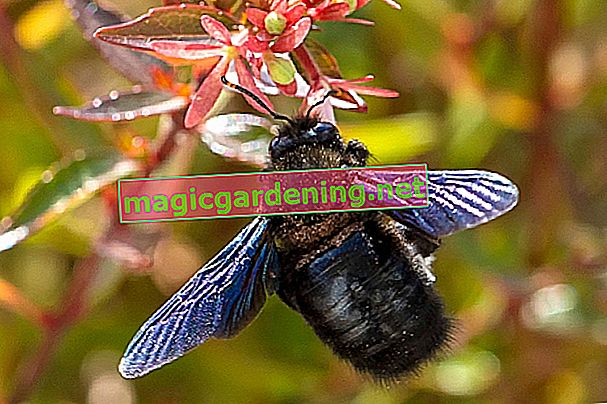
Because of its size, the blue wooden bee is often mistaken for a bumblebee. It is the largest native wild bee species and recognizable by its blue wings, which stand out against the black-colored and shiny metallic body. The blue wooden bee is a peaceful insect.
In portrait: wasps, bees, bumblebees and hornets
These insects belong to the hymenoptera and each have their own way of life, but they are similar in some respects. While bumblebees are particularly threatening due to their loud humming noises and their size, they are far safer than bees and wasps. Hornets are just as dangerous. Like bumblebees, these sting only in exceptional cases when threatened.
Interesting facts:
- Honey bee venom is more toxic than hornet venom
- Unlike males, female bumblebees have a sting
- Bumblebees, hornets and wasps only use their nests for one year
- You can buy bumblebees and bees for pollination
Where and how do bumblebees live?
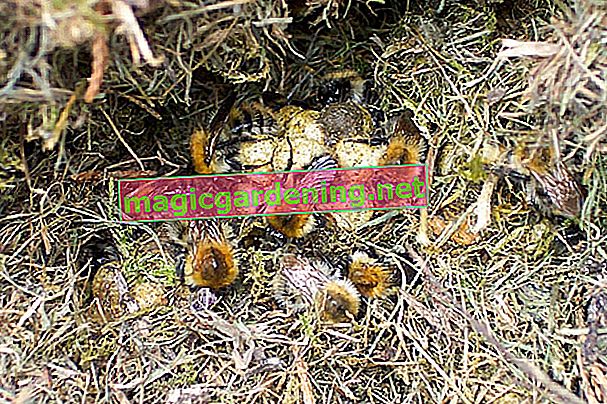
Bumblebees are social insects that support each other in the colony and help the species to survive. Unlike bees, they do not communicate about the direction and distance of a source of nectar. However, by releasing pheromones, they can tell their fellow species that there is nectar in the area. Every bumblebee must first learn which plants provide nectar and how they get the coveted food.
Typical nest structure
- Pitcher to urn-shaped cell arrangement
- Nest resembles a looser and upright heap
- A shell made of hair, grass and moss isolates the nest
- additional wax layer protects against heat loss
Digression
Breeding behavior
After the first egg-laying, the queen sits on the eggs to warm them. This creates temperatures of up to 38 degrees Celsius. The temperature in the nest is constant between 30 and 33 degrees Celsius. While breeding, the queen turns to her own food supplies so that she does not have to leave her eggs to eat.How do bumblebees nest?
In spring, the young queens look for a suitable place to build their nest. Depending on the species, the insects use different nesting sites. Earth bumblebees prefer to colonize burrows while tree bumblebees can nest in abandoned bird nests. The nests are only used for one year. Only in rare cases does the queen return to the old bumblebee nest in which she herself grew up. In the tropics there are bumblebee colonies that colonize a nest for several years.
Where bumblebees build their nests:
- in masonry : cracks and cavities
- in the garden : holes in the earth, in the moss or in hollow tree trunks
- on buildings : in the roller shutter box, under the roof or in the window frame
How many bumblebees live in a nest?
A bumblebee colony can accommodate between 50 and 600 insects. The exact number of individuals varies depending on the species. Workers make up the majority of a people. Several hundred young queens can grow up in a large state.
Why can bumblebees fly?
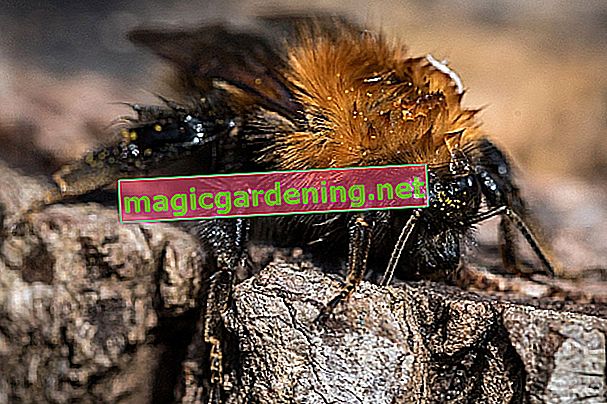
According to an aerodynamicist's calculations, bumblebees cannot actually fly. Contrary to this theory, bumblebees move in the air. They fly even in the rain and cling to a nectar-rich bloom, soaked through, to weather the bad weather. The wings of a bumblebee are extremely elastic because they mainly consist of the protein resilin. This can expand to three times its size without tearing.
Because of this high flexibility, eddies arise at the tip when the wings flap. Large volumes of air are set in motion and provide the necessary buoyancy to get the voluminous bumblebee bodies into the air.
How do bumblebees fly?
A wing can move up if there is less pressure on the top than under the wing. To reduce the pressure at the top, the wing must be curved as much as possible. The bumblebee wing has a joint in the middle, which is also made of resilin.
The bumblebee flaps its inclined wings forward. Then the wing is rotated so that the top and bottom are swapped. In this position the insect moves its wings backwards. The wing tips form the foremost point with every movement. This self-contained movement creates a vortex at the leading edge, which makes the supposedly physically impossible flight possible for the bumblebees.
What do bumblebees do in winter?
Shortly after mating, which takes place between July and August, the young queens look for a suitable place to overwinter. It has not yet been clarified why the insects are looking for wintering quarters so early in the year, because at this time there is still an abundant food supply. The young queens are therefore rarely seen, while the males can often be seen during their courtship flights. They die after mating and, like the workers, do not hibernate.
Suitable winter spots:
- Molehills
- compost
- pile of leaves
Are bumblebees dangerous?
Bumblebees can sting or bite. They have a sting and the lancing apparatus is relatively poorly developed. The potential for aggression differs from species to species. Bumblebees rarely sting, because they are the most peaceful bearers of military spines and warn enemies of an attack. Drones, on the other hand, have no sting and are completely harmless.
YoutubePrickly apparatus and poisonous effects
The sting of a bumblebee does not get stuck in the skin when it stings because it has no barbs. Therefore, bumblebees do not die after being stung. When it has pierced its stinger through the skin, the bumblebee transfers a poison into the victim. In humans, the sting causes a slight pinch. However, the poison can cause pain, itching, swelling, and redness. For most people, a bumblebee bite is harmless. Only allergy sufferers can expect severe reactions from the immune system.
defense
If a threat arises, the bumblebee first lifts its middle leg and stretches it towards the attacker. If this does not deter the enemy, the bumblebee turns on its back and stretches its stinger towards the attacker. Meanwhile she tries to scare off the enemy with loud humming noises. If the threat persists, a sting attack may result. Occasionally bumblebees also bite for defense.
Drive away bumblebees?
In Germany it is forbidden to remove a bumblebee's nest without a particular reason or to use means to kill. Anyone who acts contrary to the law can expect fines of 50,000 euros. It doesn't matter whether chemical insecticides or home remedies were used.
Bumblebees are protected and may only be relocated in exceptional cases with permission. There is an exception when an allergy sufferer can no longer use certain areas of the garden. In this case, you should contact a nature conservation organization such as the Nabu or volunteer bumblebee conservationists. In the event of immediate danger, skilled workers can remove or relocate nests.
How to keep bumblebees away:
- Protect your home with fly screens
- don't hit the bumblebees
- Only equip terraces and balconies with green plants
- Sow nectar-rich flowering plants in an undisturbed garden corner
What don't bumblebees like?

Bumblebees very rarely get lost in the barbecue area because the insects don't like smoke. If you want to get rid of bumblebees, you should avoid flowery perfumes and colorful clothing. Both of these confuse the bumblebee because it believes it has found a source of food.
Live with bumblebees
Bumblebees are important pollinators. You can pollinate flowers with long tubular florets such as broad beans and red clover. Honey bees do not get deep enough into the flower structures with their short mouthparts. In the greenhouse, bumblebees support the self-pollination of tomatoes and peppers with their vibrations, which otherwise has to be done by hand.
Bumblebees are able to raise their body temperature. This enables them to fly even in bad weather and low temperatures and to pollinate vegetables and fruit trees in bad weather periods. Even when rainy periods last the entire summer, bumblebees ensure pollination. Bees withdraw under these conditions.
Bumblebees are extremely useful and peaceful creatures that enrich any garden.
Attract bumblebees
If you've bought or built an insect hotel (€ 8.87 on Amazon *) for bumblebees, you have to do some persuasion. Only about 25 percent of all nesting aids are automatically colonized. Once the box has been inhabited, the chances of repopulation by the descendants are very high. An attractive food supply in the garden is important for its use.
To settle earth bumblebees the box is placed on the ground. Fake a mouse hole by burying a tube and letting the opening protrude from the ground. The second opening ends in the bumblebee box. The hose should have an inside diameter of 2.5 centimeters and no longer than a meter. The entrance becomes more attractive if the opening on the edge is slightly mossy.
Tips
A board leaning against the box at an angle automatically guides bumblebees to the entrance when they fly above the ground in search of a hole in the ground. When touched, they follow the board upwards.
Better flowering meadows than bumblebee houses
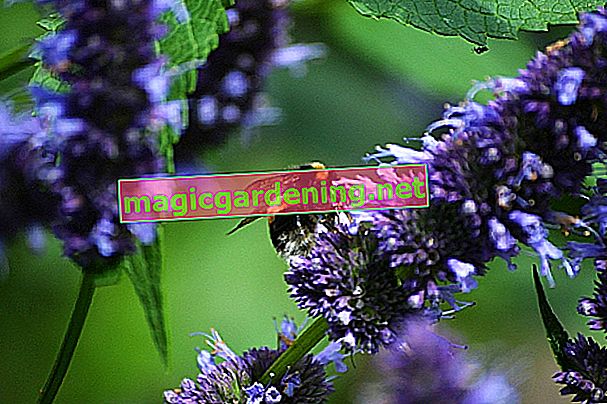
Special bumblebee boxes are available in stores, with which nature lovers and hobby gardeners can establish bumblebees in the garden. However, bumblebees rarely accept such boxes. If there are already cracks in the wood in which holes have been drilled, bumblebees completely refrain from colonization. The insects also disdain plastic and metal. Such nest boxes are more often accepted by solitary wild bees. With a species-rich flower meadow, you support the bumblebees in a natural way.
Tips
Hollow bricks offer an ideal nesting place. The entrance should be close to the ground.
Which plants like bumblebees?
So-called traditional plants have a special meaning in beekeeping. These plants are preferred by bees because they are rich in nectar and pollen. Bumblebees also like such plants. Visiting bees and bumblebees is particularly important for fruiting in fruit trees. You can specifically help bumblebees by growing such nectar plants. When choosing plants, look for a mix of early and late flowering species. In this way you guarantee a continuous supply of nectar from late winter until autumn.
Flowers for bumblebees:
- Early bloomer : crocus
- Perennials : marigold, bee friend
- Balcony flowers : Kosmea, straw flower
- Trees : rhododendron, marshmallow
- Herbs : lavender, chives, oregano
Care for weakened bumblebees
In high and late summer there is usually insufficient food and many bumblebees are too weak to reach the last flowers. You can save the insects by putting a small drop of sugar solution directly on the soil. The bumblebee smells the energy source and ingests the food with its trunk.
Bumblebees as inspiration
People are fascinated by the furry flight artists who perform even under adverse conditions. Her will to survive seems to dominate her. The special way of life of the insects always gives rise to inspiration in the media world.
- Bumblebees in the heart: novel by Petra Hülsmann
- Bumblebees in the stomach: film based on the novel by Jo Berger
- Hummeln - bees in fur: Documentary by Kurt Mündl
- Bumblebees in the ass: travel blog
- Bumblebees fly even when it rains: novel by Andrea Kraft
frequently asked Questions
Why do so many bumblebees die in summer?
In midsummer, a lack of nectar means that masses of dead bumblebees lie under linden trees. When they have discovered the coveted nectar sources, they are often too weak to reach them. Linden trees are the last important suppliers of nectar as the end of the growing season approaches. This development is particularly drastic in cities, because large areas are sealed off. The food supply is negligible here.
Here's how you can help bumblebees:
- offer a drop of sugar water
- Install the feeding station in the garden
- Plant bushes for bees and bumblebees
How old do bumblebees get?
The life expectancy of insects depends not only on environmental conditions but also on social status. Queens hibernate and can live up to a year. The workers that hatch in spring live for several months, while the foragers die after two to three weeks. In late summer, drones with a life expectancy of one month are produced.
What do bumblebees eat?
The insects feed on pollen and nectar that they collect from various flowering plants. Because of their long mouthparts, bumblebees can also get to deep nectar in long tubular flowers. Clover is one of her favorite plants. They also fly on willows, fruit trees, adder heads or oregano.
What do bumblebees do with the pollen?
The workers use the collected nectar to meet their high energy needs. To ensure the survival of the colony, the bumblebees fill their collection bladders with nectar. This is excreted as honey and serves as food for the queen and offspring in the nest.
They scrape off pollen with their belly, which is transported in the pollen sacs. The queen forms a pea-sized ball from the pollen that is covered with wax. It then lays its eggs so that the offspring can be supplied with food as soon as they hatch.
Why can bumblebees fly?
In the 1930s, the Hummel paradox circulated through the media, which was originally intended as a joke by an aerodynamicist. He made a calculation and came to the conclusion that bumblebees are actually not allowed to fly because of their unequal ratio of wing area to body volume.
It later turned out that there is no paradox here. When a bumblebee flaps its wings, it creates vortices. A bumblebee can move its wings in circles up to 200 times per second, creating tornado-like air vortices. These create a negative pressure, which causes the bumblebee to rise into the air.
Do bumblebees produce honey?
In the spring the queen goes looking for pollen and nectar to produce what is known as bee bread. The honey is excreted from the abdomen and serves as building material and energy-rich food. She forms a cell out of the honey in which she lays her first eggs. In addition, she builds a pot that is then filled with honey. The queen feeds on this supply while she hatches her eggs.








